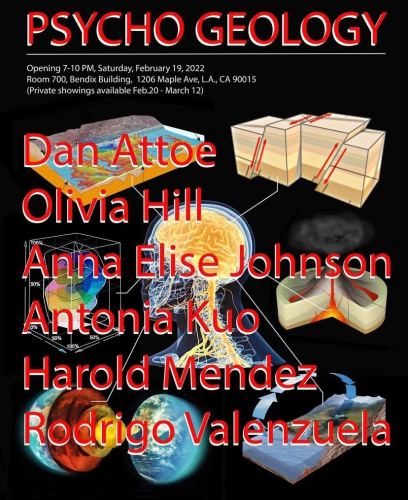
Our show, Psycho Geology, includes work by artists who are grappling with the psychological and aesthetic impact of living in the Anthropocene, the recently named current geological era in which human activity is the dominant geological force. Understanding ourselves as geological force unsettles long-held ideas of what it means to be human and dissolves the separation between ontological binaries of culture vs. nature and history vs. pre-history.
Nature can no longer be considered as sublimely beyond human influence. Nature is, in fact, in the process of a grand, if largely accidental, shift that we have caused. As artists, it is difficult to imagine ourselves existing in the same cultural realm as artists of the past. Their work was contextualized within human-centered histories, collected and organized in an art history kept apart from geological history, and was archived for a future that looked a lot like the past. Now, in a world where human culture is part of and constitutive of nature, the high walls that stood between aesthetics and geology have eroded away.
In their work, some artists avoid these destabilizing circumstances with familiar coping mechanisms: the attempt to exist in the continuous, scrolling instant with quickly made, quickly seen, sold, and stored art; the presentation of nostalgic and historically decontextualized reconstructions of past art historical modes; or the projection of authentic, individual self-expression. Aesthetically, the articulation of space, light, and time may be disregarded, allowing art to float unhinged from the past or the future. It is possible, however, that art, which has so long been confined to the domain of individual agency and choice, can paradoxically phenomenalize our lack of agency as a geological force.
The artists in this show create representations that help us process our interconnection with landscape, our unsettled and anxious relationship to our environment and our future, and both our integration with and disruption of other planetary forces.
Dan Attoe paints grand landscapes populated by small figures painted from imagination. His figures inhabit the landscapes in an uncanny, dreamlike way. They express contemplative unease, environmental uncertainty, or absurdly banal statements through thought inscriptions that stand in contrast to their monumental surroundings.
Olivia Hill paints Southern California landscapes that, while recalling the pristine beauty of California Impressionism, are modulated with large-scale infrastructure projects, “nature” constructed for leisure and entertainment, and marks left on environments by travel. Her landscapes are also technologically inflected because she paints from images found on Google Earth and names each painting according to the longitude and latitude of the Google map pinpoint.
Anna Elise Johnson has developed a process that reduces intention and choice in her work. She begins by placing large plaster soaked canvases directly upon the ground to record aspects of actual physical landscapes. Later, in her studio, she adds and subtracts layers of plaster, earth, plant matter, and pigment until the original, largely topographical, record becomes an expression of artistic choice embedded with a sense of geological change and time.
Antonia Kuo uses photochemical processes in a layered, experimental, and almost accidental way. Color and tone build and separate in an alchemy that suggests art’s isomorphy to geological processes. Her process creates images that also formally echo the pictures created by neuroimaging technologies, but the brain they map is the experimental mind of the artist.
Harold Mendez’s work juxtaposes nature and culture by creating ritualistic objects from found materials that he modulates, collages, and recombines with industrially processed materials. He poetically postulates our Anthropocenic condition through these materials and their relationship to our bodies.
Rodrigo Valenzuela’s work imagines the future of labor, technology, and national borders. In the series of work included in this show he transfers large-scale photographs of desert landscapes, and he delineates these vast spaces by drawing and painting architectural forms and vantage points upon them. He breaks up the forbidding, timeless desert vistas into human-scaled spaces that either stake claim to the landscape or create portals to imagine different relationships to ideologically loaded landscapes.
-Anna Elise Johnson, Curator